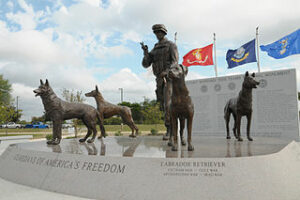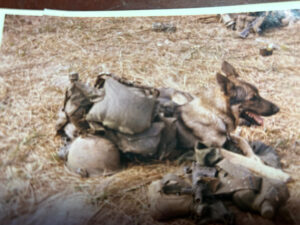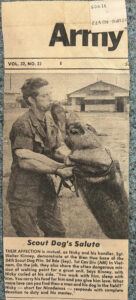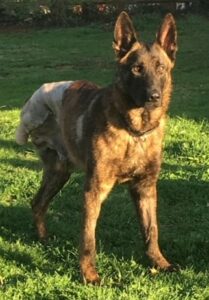
U.S. Military Working Dog Teams National Monument at Joint Base San Antonio (JBSA)-Lackland in San Antonio, Texas, represents handlers, dogs, and veterinary support, from all military service branches
March 13 is National K9 Veterans Day and the official birthday of the US Army K9 Corps. This day recognizes the dedicated K9 units that have served since World War I.
While millions of dogs have served in the armed forces since World War I, recognition of their service has often been overlooked. Vietnam K9 dogs were considered equipment, and when soldiers left in aircraft, their dogs remained grounded. The 4,900 specially trained dogs that fought alongside their handlers saved approximately 10,000 lives.
Scout Handler, Pete Thompson
A 2.5-year-old German Shepherd named Nicodemus was just one of many war dogs. When twenty-two-year-old Pete Thompson was drafted into the Army to serve in Vietnam, he learned how to be in the right place at the right time. “You couldn’t enlist to be a scout handler. You had to be there when they were looking for them, so I set myself up to do that,” he recalled. He was paired up with Nicodemus, and the two spent four months training and then shipped off to Vietnam together for another 12 months.
As a scout handler, Thompson and Nicodemus, Nic for short, walked silently in front of a company. Nic would give an alert if he detected the enemy. “If a unit thought they were in an area where there were Viet Cong, I would be dropped in by helicopter with Nic. I had a bodyguard watching me because I was watching the dog. The minute he gave the alert, my job was over.”
The Viet Cong began using dogs too, but not in the same way. “They would let dogs roam the jungle freely, hoping they would bark when they saw our dogs and give away our location. Nic would never bark back, though.”
“We lost a lot of scout handlers in Vietnam. I was lucky. My dog never let me down,” he said.
 Nicodemus never left Vietnam. “There was a disease in Vietnam that our government couldn’t risk bringing home. Nicodemus was eventually put down after working with another handler.”
Nicodemus never left Vietnam. “There was a disease in Vietnam that our government couldn’t risk bringing home. Nicodemus was eventually put down after working with another handler.”
Thompson moved on to helicopter duty but never forgot his K9. He and another soldier began to write to then-Congressman John Moss, asking for his help to bring the Vietnam K9s home: “These were real live hero dogs; it was crazy that they were being left behind.” Eventually, a veterinarian developed a test that indicated which dogs didn’t have the disease. Between this new test and Thompson’s efforts, 200 dogs came home.
Robby’s Law
Today, thanks to Robby’s Law, military dogs leave war zones with their handlers. Robby was an 8-year-old Belgian Malinois who served in the military until he developed progressive arthritis and elbow dysplasia, making him no longer able to fulfill his duties. If Robby couldn’t work even half-time, he would be euthanized. Robby’s handler realized that he would no longer be of military use and attempted to adopt the dog. When he was denied, he went public with the issue, leading to strong moral support.
Then-Congressman Roscoe Bartlett heard of the case and drafted a bill that eventually became what is now known as Robby’s Law. Unfortunately, Robby’s illnesses had progressed too far by this point, and he was euthanized on January 19, 2001.
Robby’s Law was signed by Congress in 2000 and requires the Secretary of Defense to submit a report to Congress each year on the “disposition” of Military Working Dogs (MWDs)—the numbers adopted, transferred to law enforcement, euthanized, or disposed of by other means.
Paw Patrol Program
Hero’s Bridge Paw Patrol volunteer, Carolyn Olech, brings to the program vast canine expertise. Carolyn has been a part of the National Veterinary Response Team, working as a Veterinary Medical Officer since 2009. A large part of her duty is serving on the working dog treatment task force, providing veterinary care to working dogs (Law Enforcement/Police dogs, Military Working Dogs, other governmental agencies, and security K9s) during national security events and national disasters.
During fit-for-duty exams, Carolyn helps classify K9s into one of four categories:
- CATEGORY 1, Unrestricted Deployment.
- CATEGORY 2, Restricted Deployment.
- CATEGORY 3, Temporarily Non-Deployable.
- CATEGORY 4, Non-Deployable.
Dutch Shepherd Frank fell into Category 4 following an off-duty kennel accident when he was 15 months old. Frank was a single-purpose explosive detection K9, training to go to a Middle Eastern country to look for explosives in airports when the accident occurred.
Frank was lucky to be adopted by Carolyn and her partner, JD. Carolyn was one of the veterinarians who assisted in Frank’s amputation surgery and extensive post-op care. With no 24/7 care at the facility, Carolyn brought Frank home and spent a lot of time nursing him back to health. Frank and Carolyn’s other dog, Rosa, would lay by his side during recovery, and the two bonded.
Today, Carolyn and JD bring their “K9 Crew”, Frank, Rosa, and Lili, on visits to senior facilities, mainly Culpeper Health and Rehab.
Carolyn’s passion for dogs is evident. “These dogs are performing major duties critical to the safety of so many people. The dogs don’t grasp what is being asked of them. They are performing what they learned during training to please their handler. Working dogs just love to work and their work potentially saves many lives. It’s an honor to be a small part of that.”
Hero’s Bridge recognizes the significant contributions to safety from our military and first responder K9s.




